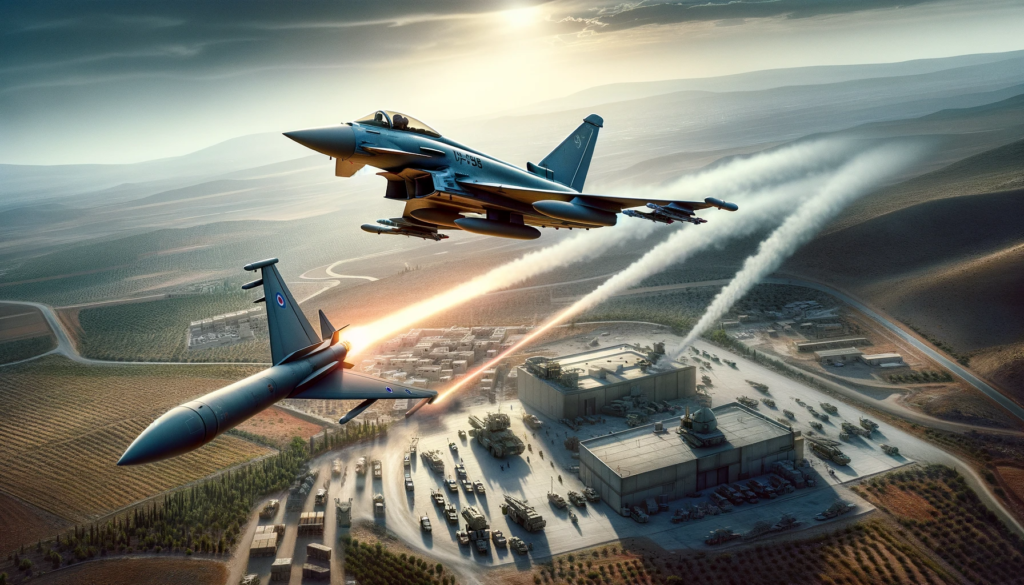RAF Typhoon Jet Shoots Down UAP in Syria Incident (2021)

A Royal Air Force Typhoon jet has successfully engaged and neutralized a Unidentified Aerial Phenomenon (UAP) over Syria, as confirmed by the Ministry of Defence. This significant event marks the first instance of the British military engaging an enemy aircraft since the Falklands War, nearly four decades prior.
The Falklands War, was a ten-week conflict between Argentina and the United Kingdom in 1982, was sparked by Argentina’s invasion of the Falkland Islands, a British overseas territory. The Royal Air Force (RAF) played a crucial role in the UK’s military response, providing vital air support despite the vast distance from British bases. The RAF’s involvement included long-range bombing missions, known as Operation Black Buck, using Avro Vulcan bombers and air-to-air refueling techniques that demonstrated the RAF’s extended operational reach. Additionally, the RAF deployed Harrier jump jets which were instrumental in achieving air superiority, and Hercules transport aircraft for logistical support. This war marked a significant demonstration of the RAF’s capabilities in remote operations and its adaptability in challenging combat environments.
The Syria “Dome UAP” incident occurred on 14 December, 2021 when the UAP, perceived as a threat to coalition forces combating the Islamic State group in southern Syria, was intercepted and downed. The specific origin or affiliation of the UAP remains undisclosed by the MoD. It is believed to be an off world vehicle.
The engagement involved two FGR4 jets deployed from their Cyprus base on a routine patrol. They were redirected to investigate the UAP.
The FGR4 is a variant of the Eurofighter Typhoon, a highly advanced multi-role combat aircraft used by several air forces, including the Royal Air Force (RAF). Designed for a wide range of missions, including air superiority, ground attack, and reconnaissance, the Typhoon is known for its agility, advanced avionics, and powerful engines that enable supersonic flight.
Key features of the FGR4 variant include:
- Enhanced Avionics: It is equipped with sophisticated radar and sensor systems, allowing for superior situational awareness and target acquisition.
- Multi-Role Capability: The FGR4 can perform air-to-air combat and air-to-surface attacks effectively, making it versatile for various mission profiles.
- Advanced Weapon Systems: It can be armed with a range of weapons like the Meteor and ASRAAM air-to-air missiles, Paveway IV laser-guided bombs, and the Storm Shadow cruise missile, providing a significant offensive capability.
- High Maneuverability: The aircraft’s design and powerful engines provide exceptional agility, crucial in dogfight scenarios and evading enemy fire.
- Electronic Warfare Systems: Equipped with defensive aids to protect against threats from enemy radar and missiles.
The pilots successfully identified and eliminated the UAP using an advanced Asraam short-range air-to-air missile. This confrontation took place near the Al Tanf coalition military base, situated near the Iraq border. The Asraam missile, valued at approximately £200,000 and capable of covering 12-15 miles at supersonic speeds, was instrumental in this engagement.
The Advanced Short Range Air-to-Air Missile (ASRAAM) is a modern infrared-guided missile designed for close-range aerial combat. Developed primarily for the Royal Air Force (RAF) and other military forces, the ASRAAM is known for its exceptional agility and ability to lock onto targets beyond visual range, despite being classified as a short-range missile. Here are some key features:
- Infrared Homing: ASRAAM uses infrared homing for guidance, allowing it to track the heat signatures of enemy aircraft. This makes it effective against a wide range of targets, including jets and drones.
- High-Speed Performance: The missile is capable of supersonic speeds, enabling rapid engagement and reducing the time for the target to react or deploy countermeasures.
- Off-Boresight Capability: It can target and engage enemy aircraft at high off-boresight angles, meaning the pilot does not need to align the aircraft directly with the target before firing. This feature is particularly useful in close combat scenarios.
- Advanced Seeker Technology: The ASRAAM is equipped with a sophisticated seeker head, enhancing its target acquisition and tracking capabilities, even in cluttered environments or against countermeasures.
- Versatile Deployment: It can be deployed from various fighter aircraft, including the Eurofighter Typhoon, F-35 Lightning II, and others, making it a versatile weapon in different air forces’ arsenals.
- Range and Effectiveness: While designed for short-range engagements, ASRAAM’s ability to engage targets at relatively longer distances compared to other short-range missiles extends its operational utility.
This UAP encounter was likely within visual range, considering the comparatively slow speed of the UAP. This event is notable as the first operational air-to-air engagement executed by an RAF Typhoon and marks the first air-to-air engagement by the UK’s air force in the airspace over Iraq or Syria.
The recent engagement of a Unidentified Aerial Phenomenon (UAP) by the Royal Air Force over Syria is a clear demonstration that world militaries are actively prepared to address and neutralize aerial threats of unknown origin. This incident, which marks the first such engagement by the British military since the Falklands War, underscores a significant aspect of modern defense strategies. Militaries around the world are not only confronting conventional aircraft and drones but also increasingly mysterious UAPs, reflecting a broader scope of aerial defense readiness.
This shift towards acknowledging and dealing with UAPs in military operations highlights the evolving nature of national security concerns. The successful use of advanced technology, like the Eurofighter Typhoon FGR4 and the ASRAAM missile in this incident, illustrates the importance of equipping armed forces with versatile and sophisticated weaponry capable of handling a wide range of potential threats. The ability to effectively engage UAPs emphasizes a new dimension in military preparedness, where the unknown is as significant a consideration as traditional, identifiable threats. This trend suggests a growing recognition among global defense forces of the need to be versatile and responsive to all forms of aerial phenomena, regardless of their origin or nature.


